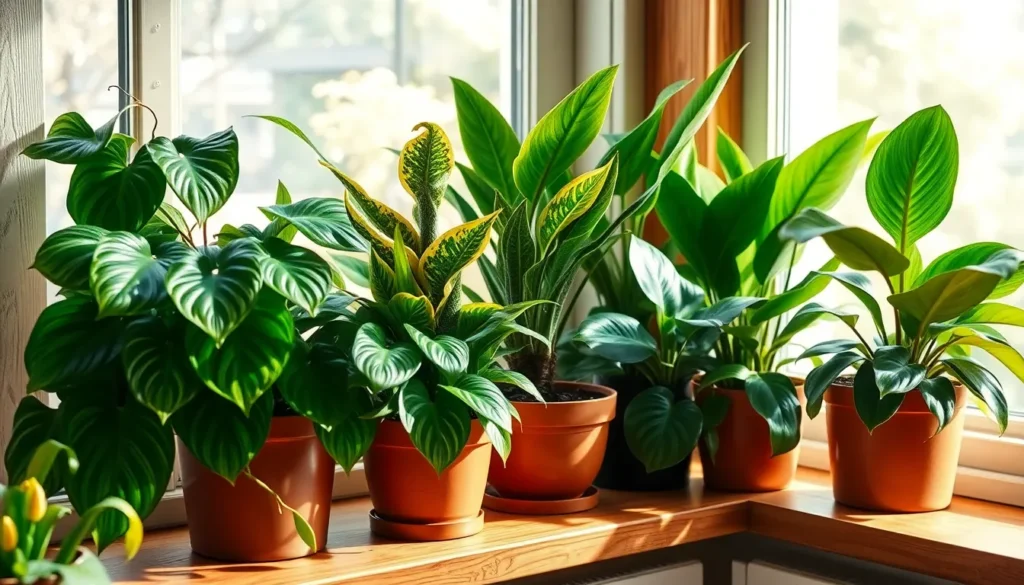We’ve all walked through a stunning garden and wondered about the names of those eye-catching plants that make our hearts skip a beat. Whether you’re a beginner gardener or someone looking to expand your green knowledge, identifying beautiful ornamental plants can transform your outdoor space from ordinary to extraordinary.
From vibrant flowering shrubs to elegant foliage plants, ornamental varieties offer endless possibilities for creating breathtaking landscapes. We understand that choosing the right plants can feel overwhelming when you don’t know their names or growing requirements.
That’s why we’ve compiled this comprehensive guide to help you discover the most popular ornamental plants along with their proper names and key characteristics. You’ll soon be able to confidently select plants that’ll thrive in your garden while impressing visitors with your botanical expertise.
Popular Indoor Ornamental Plants With Names for Beginners
We’ve curated the most forgiving indoor ornamental plants that thrive even with minimal care. These popular choices deliver stunning visual appeal while teaching you essential plant care skills.
Pothos (Epipremnum Aureum)
Pothos stands out as the perfect starter plant for anyone new to indoor gardening. Golden pothos features heart-shaped leaves with distinctive yellow variegation that brightens any corner of your home. This resilient vine tolerates low light conditions and infrequent watering better than most ornamental plants.
Growing pothos requires minimal effort since it adapts to various light conditions from bright indirect light to dimly lit spaces. Water your pothos when the top inch of soil feels dry to the touch, typically every 7-10 days. Trailing vines can extend up to 10 feet long, making pothos ideal for hanging baskets or climbing moss poles.
Common varieties include golden pothos, marble queen, and neon pothos, each offering unique leaf patterns and colors. Propagation happens easily by placing stem cuttings in water until roots develop within 2-3 weeks.
Snake Plant (Sansevieria Trifasciata)
Snake plants earn their reputation as nearly indestructible ornamental plants that survive neglect beautifully. Thick, upright leaves display striking dark green coloration with yellow edges that create architectural interest in modern spaces. These drought-tolerant plants can go weeks without water, making them perfect for busy beginners.
Positioning snake plants in bright indirect light promotes optimal growth, though they tolerate low light conditions remarkably well. Watering should occur only when soil completely dries out, usually every 2-3 weeks during growing season. Overwatering poses the biggest threat to snake plant health, often leading to root rot.
Height varies from 6 inches to 4 feet depending on the variety you choose. Popular cultivars include snake plant laurentii with yellow leaf margins and snake plant moonshine featuring silvery-green foliage. Air purification benefits make snake plants excellent bedroom companions since they release oxygen at night.
Peace Lily (Spathiphyllum)
Peace lilies combine elegant white blooms with glossy dark green foliage to create stunning focal points indoors. These graceful ornamental plants signal their watering needs by drooping their leaves dramatically when thirsty. Bright indirect light encourages regular blooming cycles throughout the year.
Consistent moisture keeps peace lilies happy, requiring weekly watering during active growth periods. Humidity levels above 40% support healthy leaf development and prevent brown leaf tips from forming. Filtered or distilled water works best since peace lilies are sensitive to chemicals in tap water.
Blooming occurs naturally when plants receive adequate light and proper care, producing distinctive white spathes that last 4-6 weeks. Common varieties include sensation peace lily reaching 4-6 feet tall and compact domino peace lily perfect for smaller spaces. Regular misting increases humidity levels and keeps leaves dust-free and glossy.
Colorful Flowering Ornamental Plants With Names for Gardens

Garden enthusiasts often seek flowering plants that deliver stunning visual impact throughout the growing season. These vibrant bloomers transform outdoor spaces into colorful sanctuaries that captivate visitors and create lasting impressions.
Rose (Rosa Species)
Roses represent the pinnacle of garden elegance with their large, fragrant blooms available in countless colors from deep crimson to pristine white. These classic flowering plants thrive in full sun conditions and adapt beautifully to various garden roles, including border plantings, formal beds, and climbing applications along fences or trellises. Rose bushes produce their most spectacular displays during spring and summer months when properly planted in well-drained soil. We recommend choosing disease-resistant varieties to ensure long-term success and minimize maintenance requirements.
Marigold (Tagetes)
Marigolds deliver exceptional value as vibrant annual flowers that bloom continuously throughout the entire growing season. Their cheerful yellow, orange, and red blossoms create striking focal points while serving dual purposes as natural pest deterrents in vegetable gardens and flower beds. These hardy plants tolerate various soil conditions and require minimal care once established, making them perfect choices for novice gardeners. Marigold flowers maintain their bright colors even during hot summer months, providing consistent visual appeal when other plants may struggle.
Petunia (Petunia × Atkinsiana)
Petunias offer remarkable versatility as popular garden annuals featuring an extensive range of colors, patterns, and flower forms including solid, striped, and uniquely speckled varieties. These flowering plants excel in full sun locations with well-drained soil and reward gardeners with continuous blooms from spring through fall. We particularly appreciate petunias for their adaptability to containers, hanging baskets, and border plantings where their cascading growth habit creates stunning visual displays. Their trumpet-shaped flowers attract butterflies and hummingbirds, adding ever-changing movement to garden spaces.
Low-Maintenance Succulent Ornamental Plants With Names
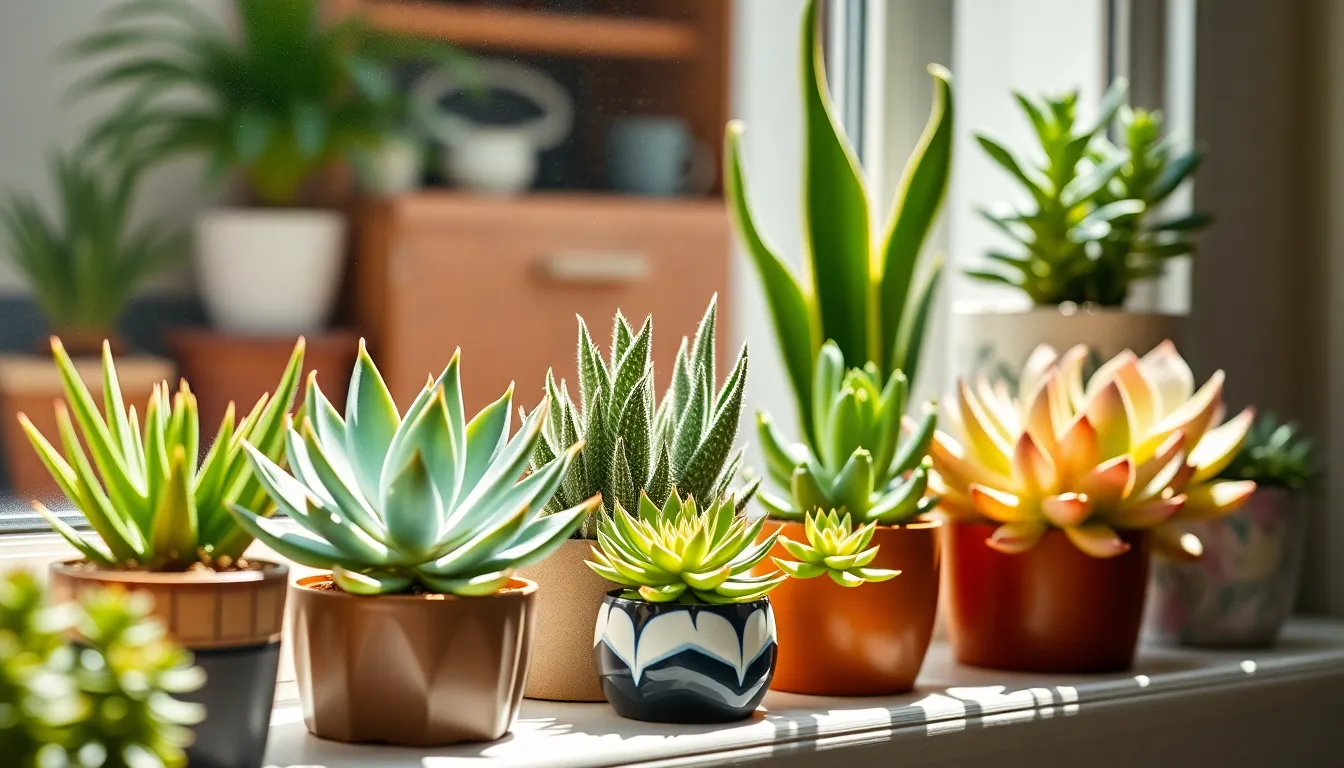
We’ve covered vibrant flowering plants and indoor favorites, but succulent ornamental plants deserve special recognition for their exceptional drought tolerance and minimal care requirements.
Aloe Vera (Aloe Barbadensis)
Aloe Vera stands out as the most popular succulent ornamental plant, combining medicinal benefits with stunning visual appeal. We love how this drought tolerant beauty thrives in bright, indirect sunlight while requiring minimal watering throughout the year.
Growing conditions that make Aloe Vera perfect for beginners include its ability to survive in poor soil conditions and withstand extended dry periods. Thick, fleshy leaves store water efficiently, allowing this ornamental succulent to flourish even when we forget to water it occasionally.
Placement options range from sunny windowsills to outdoor rock gardens, making Aloe Vera incredibly versatile for any decorating scheme. Indoor cultivation works exceptionally well since this plant adapts beautifully to various lighting conditions while maintaining its attractive rosette formation.
Jade Plant (Crassula Ovata)
Jade Plant earns its reputation as the ultimate “no fuss” ornamental succulent, making it ideal for gardeners seeking beautiful plants without complex care routines. We recommend this species for absolute beginners because it tolerates neglect while developing an attractive tree like appearance over time.
Distinctive features include thick, oval shaped leaves that create a miniature tree silhouette, adding architectural interest to any space. Low watering requirements mean we can enjoy this ornamental plant’s beauty without worrying about daily maintenance schedules or complex feeding routines.
Versatility shines through its ability to thrive both indoors and outdoors, adapting to bright light conditions while tolerating occasional periods of lower illumination. Growth patterns develop slowly but steadily, rewarding patient gardeners with an increasingly impressive sculptural presence.
Echeveria (Echeveria Species)
Echeveria species deliver outstanding ornamental value through their rosette forming growth patterns and colorful, fleshy leaves that vary dramatically in shape and size. We appreciate how these drought tolerant succulents create stunning visual displays in rock gardens, containers, and indoor collections.
Color variations range from deep purples and blues to soft pinks and silvery greens, offering endless possibilities for creating eye catching arrangements. Bright sunlight brings out the most vibrant coloration while minimal watering keeps these ornamental plants healthy and compact.
Design applications include mass plantings in xeriscapes, focal points in container gardens, and striking houseplant displays that require virtually no daily attention. Easy maintenance combined with exceptional ornamental appeal makes Echeveria species perfect for busy gardeners who want maximum visual impact with minimal time investment.
Exotic Tropical Ornamental Plants With Names
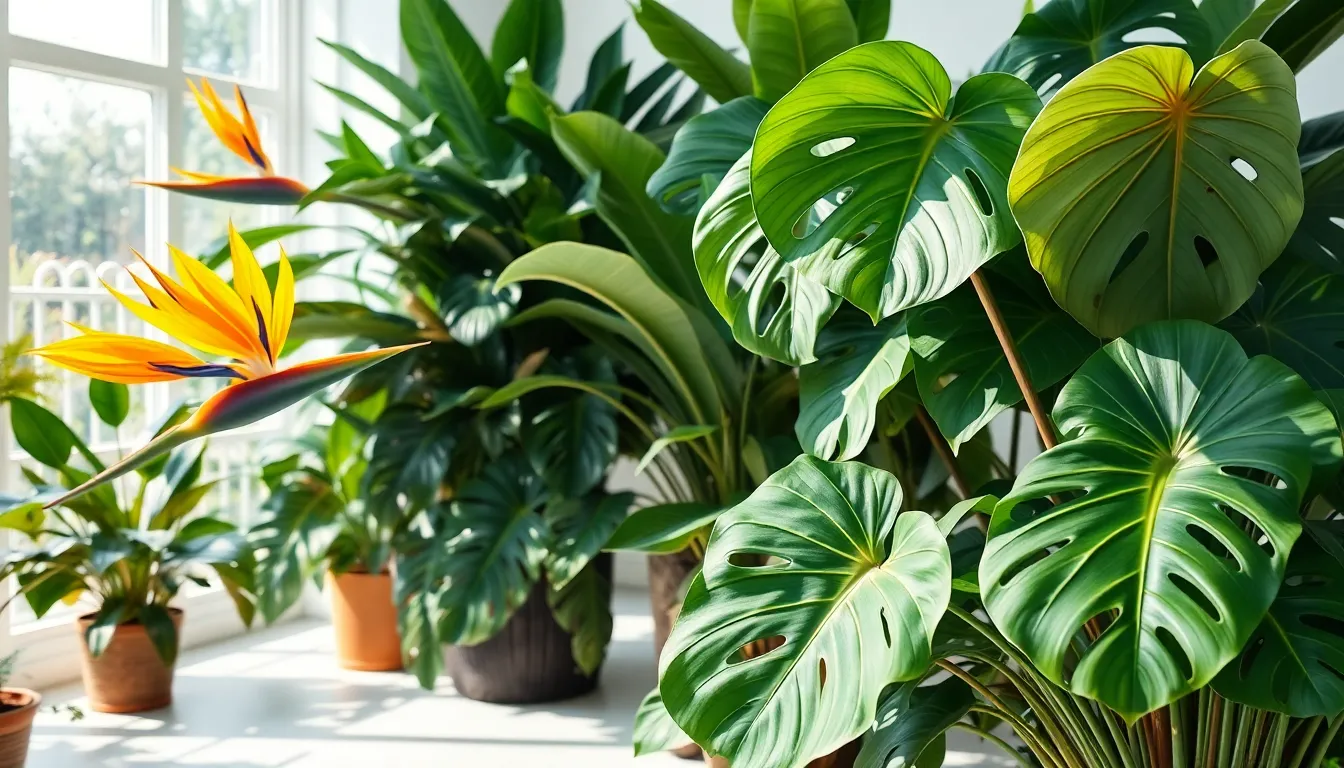
Exotic tropical ornamental plants bring extraordinary beauty and dramatic flair to our gardens and indoor spaces. These stunning plants showcase nature’s most spectacular forms, vibrant colors, and unique characteristics that create unforgettable visual impact.
Bird of Paradise (Strelitzia Reginae)
Bird of Paradise transforms any space with its striking orange and blue flowers that perfectly mimic a bird in flight. Native to South Africa, this extraordinary plant thrives in warm climates and has become a favorite choice for tropical landscaping and indoor decoration. We’ve found that bright sunlight and well-drained soil create the perfect conditions for this ornamental showstopper.
Vibrant orange petals emerge from blue sepals, creating nature’s most recognizable bird-like bloom. The plant’s paddle-shaped leaves grow up to 18 inches long, providing a lush tropical backdrop for the spectacular flowers. Gardeners appreciate how this ornamental plant blooms year-round in suitable climates, offering continuous exotic beauty.
Growing conditions require temperatures above 65°F and protection from strong winds that can damage the large leaves. We recommend placing Bird of Paradise in south-facing locations for optimal sunlight exposure. Indoor varieties need bright, indirect light and regular misting to maintain the humidity levels these tropical beauties crave.
Monstera Deliciosa (Swiss Cheese Plant)
Monstera Deliciosa captivates plant enthusiasts with its large, glossy leaves featuring distinctive holes and dramatic splits. Native to tropical rainforests of Central America, this ornamental plant has become one of the most sought-after houseplants worldwide. The unique fenestrations (natural holes) develop as the plant matures, creating increasingly impressive foliage displays.
Large heart-shaped leaves can reach 3 feet in diameter, making this plant a stunning focal point in any room. We’ve observed that younger plants start with solid leaves, gradually developing their characteristic splits and holes as they grow. The plant’s climbing nature allows it to reach impressive heights when provided with proper support structures.
Optimal growing conditions include indirect light and high humidity levels that mimic its native rainforest environment. We suggest placing this ornamental plant away from direct sunlight, which can scorch the beautiful leaves. Regular misting and well-draining potting soil help maintain the moisture balance these tropical plants require for healthy growth.
Fiddle Leaf Fig (Ficus Lyrata)
Fiddle Leaf Fig stands out among ornamental plants with its distinctive violin-shaped leaves and impressive stature. Native to western Africa, this tropical beauty has become the ultimate statement plant for modern interior design. The large, leathery leaves create architectural interest and bring natural elegance to contemporary spaces.
Individual leaves can grow up to 18 inches long and 12 inches wide, creating dramatic visual impact in any setting. We’ve noticed that healthy plants develop thick, sturdy trunks that support the substantial foliage canopy. The glossy green leaves feature prominent veining that adds texture and depth to the plant’s overall appearance.
Successful cultivation requires bright, indirect light and careful attention to watering schedules. We recommend allowing the top inch of soil to dry between waterings, as overwatering can quickly damage this ornamental plant’s root system. Consistent temperatures between 60-75°F and protection from drafts help maintain the plant’s health and prevent leaf drop.
Aromatic Herb Ornamental Plants With Names
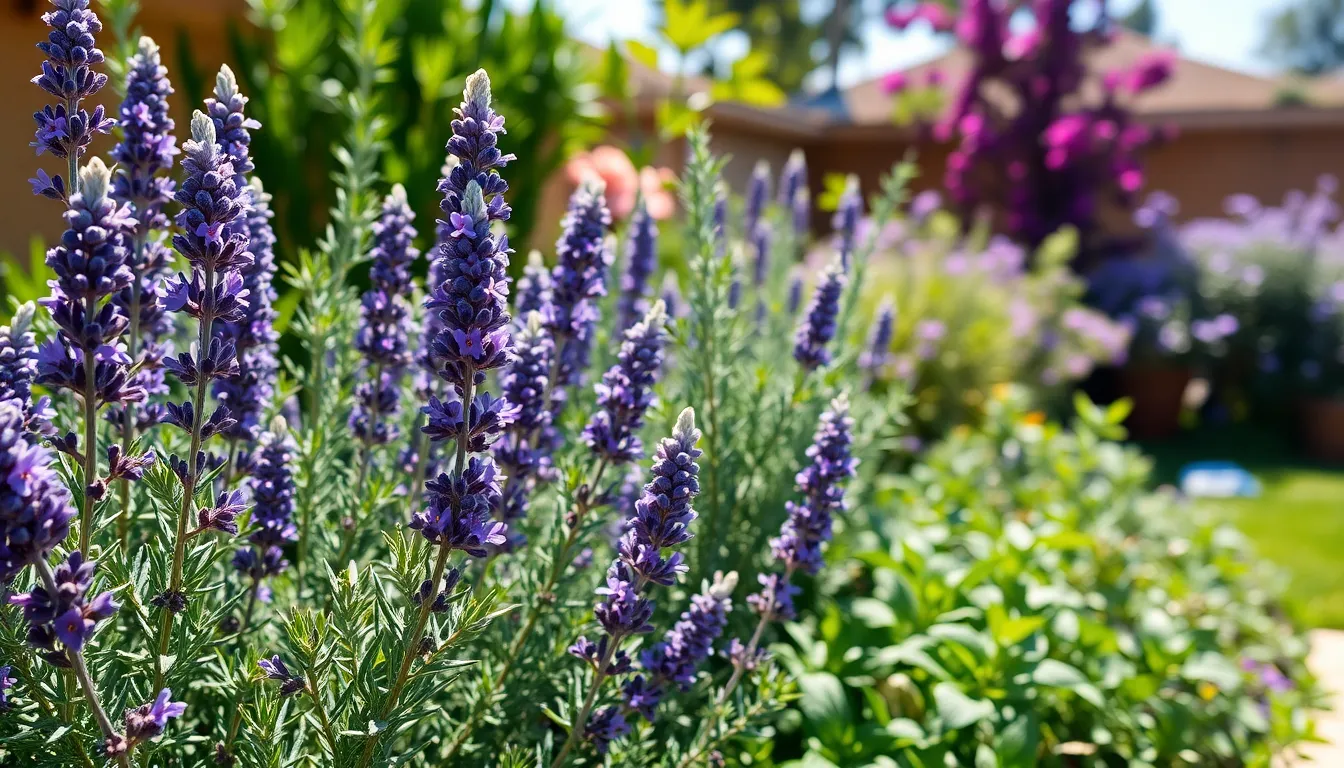
Aromatic herbs bring dual functionality to our gardens by offering stunning visual appeal alongside practical culinary and therapeutic benefits. These fragrant beauties from the Lamiaceae family excel as ornamental plants while providing us with valuable herbs for cooking and natural remedies.
Lavender (Lavandula)
Lavender transforms gardens into fragrant sanctuaries with its silvery-grey evergreen foliage and delicate purple flower spikes. This beloved ornamental herb belongs to the mint family and attracts bees and pollinators throughout its blooming season. We find that Lavandula angustifolia ‘Hidcote’, commonly known as English lavender, stands out as one of the most popular varieties for home gardens.
Growing conditions for lavender require well drained soil and ample sunshine to thrive. Pruning becomes essential in spring and after flowering to maintain its compact shape and encourage new growth. The plant’s fragrant flowers range from deep purple to white and pink, creating stunning visual displays while releasing their signature calming scent.
Rosemary (Rosmarinus Officinalis)
Rosemary serves as a woody evergreen shrub that combines culinary value with year round ornamental beauty. The needle like leaves display green coloring on top with white fuzzy undersides, creating interesting textural contrast in garden designs. Small showy flowers bloom in clusters along the shoots, featuring distinctive two lipped corolla shapes in blue, lavender, white, or occasionally pink hues.
Blooming season extends from spring through summer, providing us with an extended period of visual interest. The strongly aromatic leaves make this plant invaluable for cooking while maintaining its role as an attractive industry specimen. We appreciate rosemary’s ability to function as both a practical herb garden staple and an ornamental focal point.
Mint (Mentha Species)
Mint species offer diverse aromatic options for gardeners seeking fragrant perennial herbs with multiple uses. These plants feature characteristic square stems and opposite leaves that release strong minty or sage like fragrances when crushed. The Lamiaceae family genus includes popular varieties such as spearmint and peppermint, each bringing unique scent profiles to garden spaces.
Recognition becomes easy through their distinctive aromatic leaves and the powerful odor released during handling. We value mint plants for their sensory appeal in gardens, along with their culinary and medicinal properties. The diverse species within this genus provide us with many options for creating fragrant herb gardens that serve both ornamental and practical purposes.
Climbing and Trailing Ornamental Plants With Names
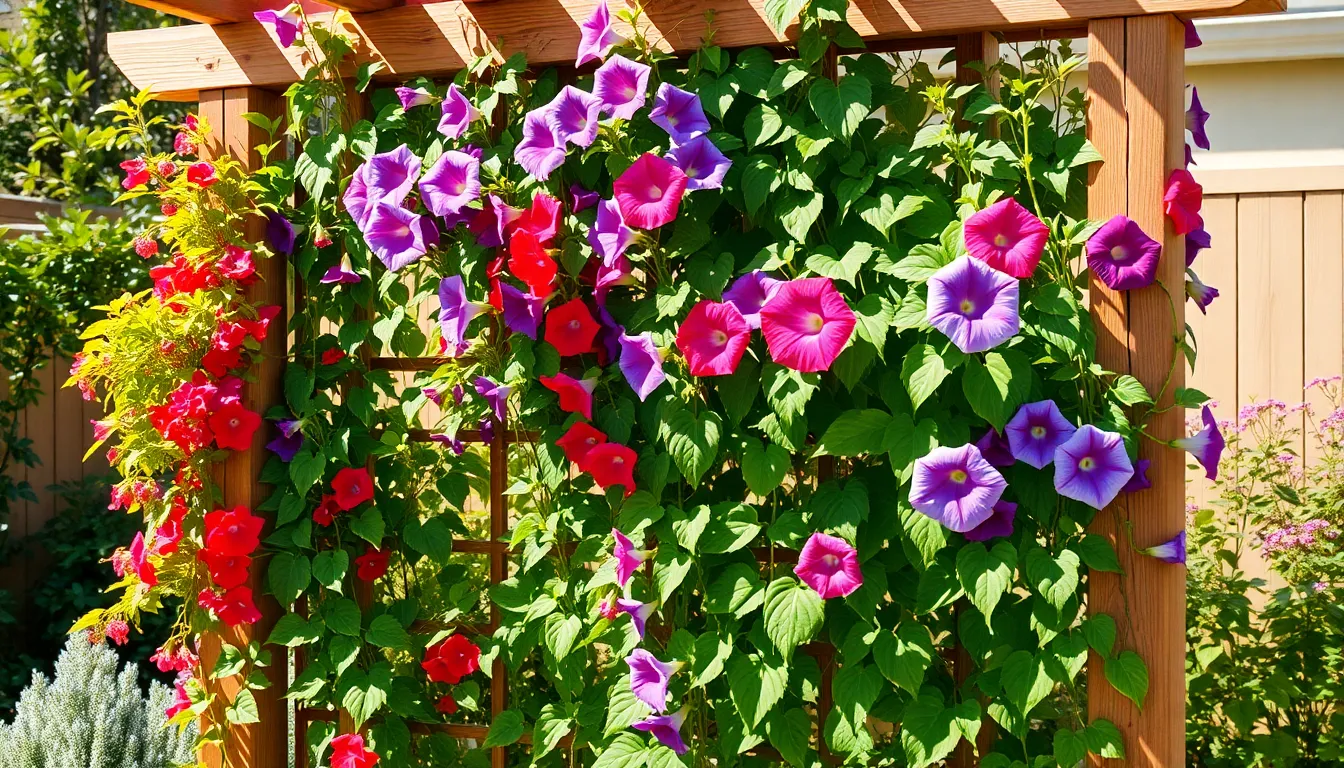
Vertical gardening takes on new dimensions with climbing and trailing ornamental plants that transform ordinary spaces into lush, living landscapes. These remarkable plants create privacy screens, cool building facades, and add stunning visual interest to gardens through their natural ability to climb or cascade gracefully.
English Ivy (Hedera Helix)
English Ivy stands as one of nature’s most reliable evergreen climbers, attaching itself to surfaces using small rootlets that grip walls and fences with remarkable tenacity. We appreciate this hardy vine for its ability to create dense, year-round foliage coverage that thrives in challenging conditions from deep shade to partial sun.
Adaptability defines English Ivy’s greatest strength, as it flourishes in various soil types and weather conditions while maintaining its glossy, lobed leaves throughout all seasons. Gardeners often choose this climbing plant for covering unsightly walls, creating living privacy screens, or establishing ground cover in difficult areas where other plants struggle to survive.
Care requirements remain minimal once established, making English Ivy perfect for busy homeowners who want maximum visual impact with minimal maintenance effort. This versatile ornamental plant tolerates urban pollution, drought conditions, and temperature fluctuations while continuing to spread and thicken over time.
Boston Ivy (Parthenocissus Tricuspidata)
Boston Ivy captivates gardeners with its spectacular seasonal transformation, displaying glossy green leaves during summer that burst into vibrant red, orange, and yellow hues each fall. We recommend this deciduous vine for its unique climbing method using adhesive pads that attach securely to smooth surfaces without causing structural damage.
Architectural applications showcase Boston Ivy’s cooling properties as it naturally reduces building temperatures during hot summer months while creating stunning visual displays. This ornamental climber grows best in full sun to partial shade conditions, reaching impressive heights while maintaining its distinctive three-lobed leaf pattern.
Seasonal interest peaks during autumn when Boston Ivy’s foliage creates breathtaking color displays that rival any flowering plant for visual drama. Property owners frequently select this climbing vine for covering brick walls, stone facades, and modern building surfaces where its natural adhesive abilities eliminate the need for additional support structures.
Morning Glory (Ipomoea Purpurea)
Morning Glory enchants gardeners with its trumpet-shaped flowers that unfurl each dawn in brilliant shades of purple, blue, pink, and white, creating daily floral celebrations throughout the growing season. We value this fast-growing twining vine for its ability to provide quick coverage of trellises, fences, and pergolas while attracting beneficial pollinators to our gardens.
Rapid growth characterizes Morning Glory’s most appealing feature, as this annual vine can cover substantial areas within a single growing season when provided with full sun and well-drained soil conditions. Gardeners appreciate its vigorous twining habit that spirals around support structures, creating natural screens and vertical garden displays.
Flower production continues from summer through first frost, ensuring continuous color and visual interest when many other climbing plants begin to fade. This ornamental vine requires minimal care beyond initial planting and occasional watering, making it ideal for novice gardeners seeking dramatic results with minimal investment of time and effort.
Large Statement Ornamental Plants With Names for Landscaping
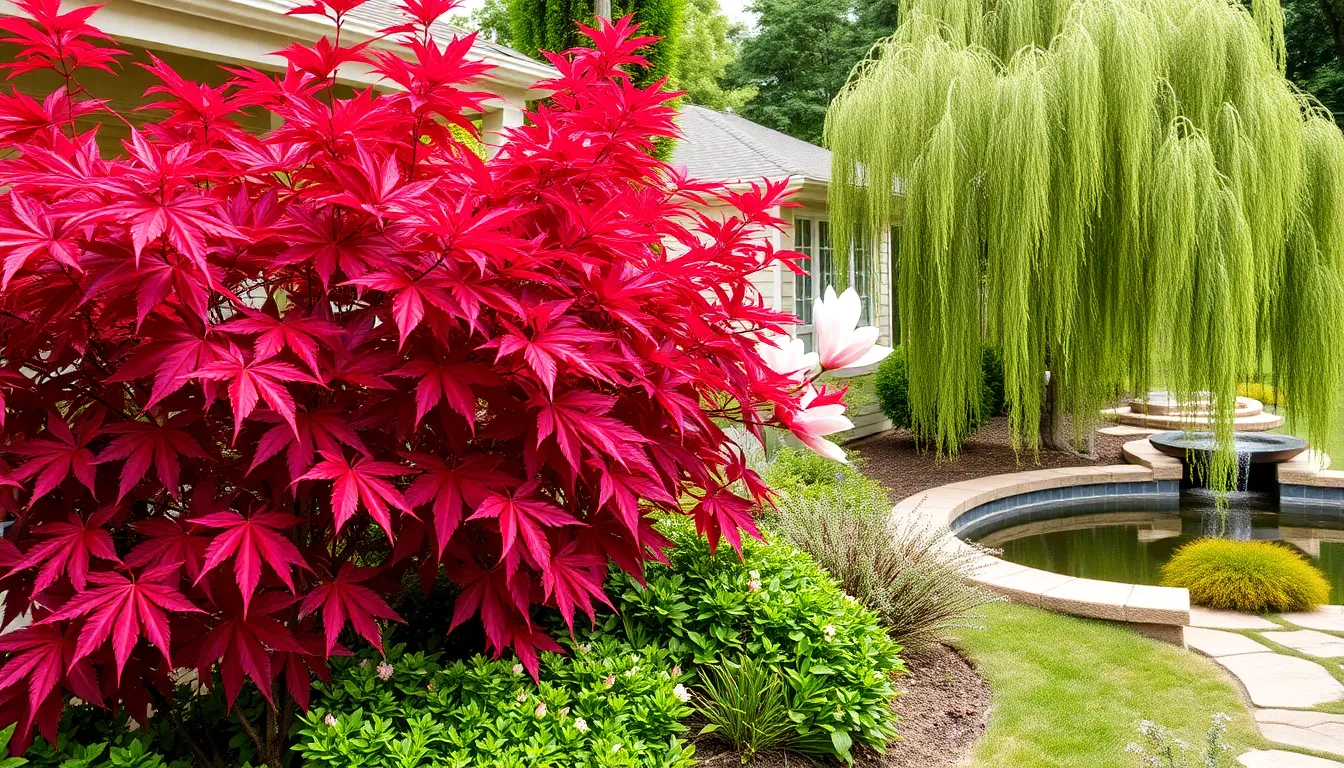
When we want to create dramatic focal points in our outdoor spaces, large statement ornamental plants deliver the visual impact that transforms ordinary landscapes into extraordinary gardens. These magnificent specimens serve as living sculptures that anchor our design while providing year round interest.
Japanese Maple (Acer Palmatum)
Japanese Maple stands as one of our most beloved statement trees with its delicate, deeply lobed leaves that create stunning architectural interest. We’ll find this deciduous beauty transforms throughout the seasons, displaying vibrant shades of red, orange, and yellow during autumn months. Gardens benefit from its elegant structure and compact size, making it perfect for smaller landscapes where we need maximum visual impact.
Care requirements favor partial shade conditions with well drained soil that receives moderate watering. We should protect these ornamental treasures from strong winds that can damage their delicate foliage. Popular varieties include ‘Bloodgood’ with deep red leaves, ‘Coral Bark’ featuring bright red winter stems, and ‘Weeping Green Laceleaf’ with cascading branches.
Magnolia (Magnolia Species)
Magnolia trees command attention with their large, fragrant flowers that bloom in spectacular displays of white, pink, purple, or yellow depending on the species we choose. These stunning ornamentals range from small trees to large shrubs, providing glossy green leaves and showy blossoms that create breathtaking spring displays. We can expect these statement plants to serve as conversation starters in any industry design.
Growing conditions thrive in full sun to partial shade with slightly acidic, rich, well drained soil that supports their extensive root systems. Species like Southern Magnolia (Magnolia grandiflora) offer evergreen foliage with enormous white flowers, while Star Magnolia (Magnolia stellata) provides early spring blooms on compact frames. Saucer Magnolia (Magnolia × soulangeana) delivers pink and white tulip shaped flowers that appear before the leaves emerge.
Weeping Willow (Salix Babylonica)
Weeping Willow creates one of nature’s most dramatic silhouettes with its graceful, cascading branches that sweep toward the ground in elegant arcs. We often plant this fast growing statement tree near water features or lakes where its romantic appearance reflects beautifully in still water. Landscapes gain instant maturity and serene beauty when we incorporate these magnificent specimens into our designs.
Environmental needs require full sun exposure and plenty of water, with these ornamental giants tolerating wet soils exceptionally well. We should provide adequate space since mature trees can reach 25 to 40 feet in height with equal spread. Root systems grow aggressively, so we must plant them away from foundations, septic systems, and underground utilities to prevent future complications.
Seasonal Ornamental Plants With Names for Year-Round Beauty
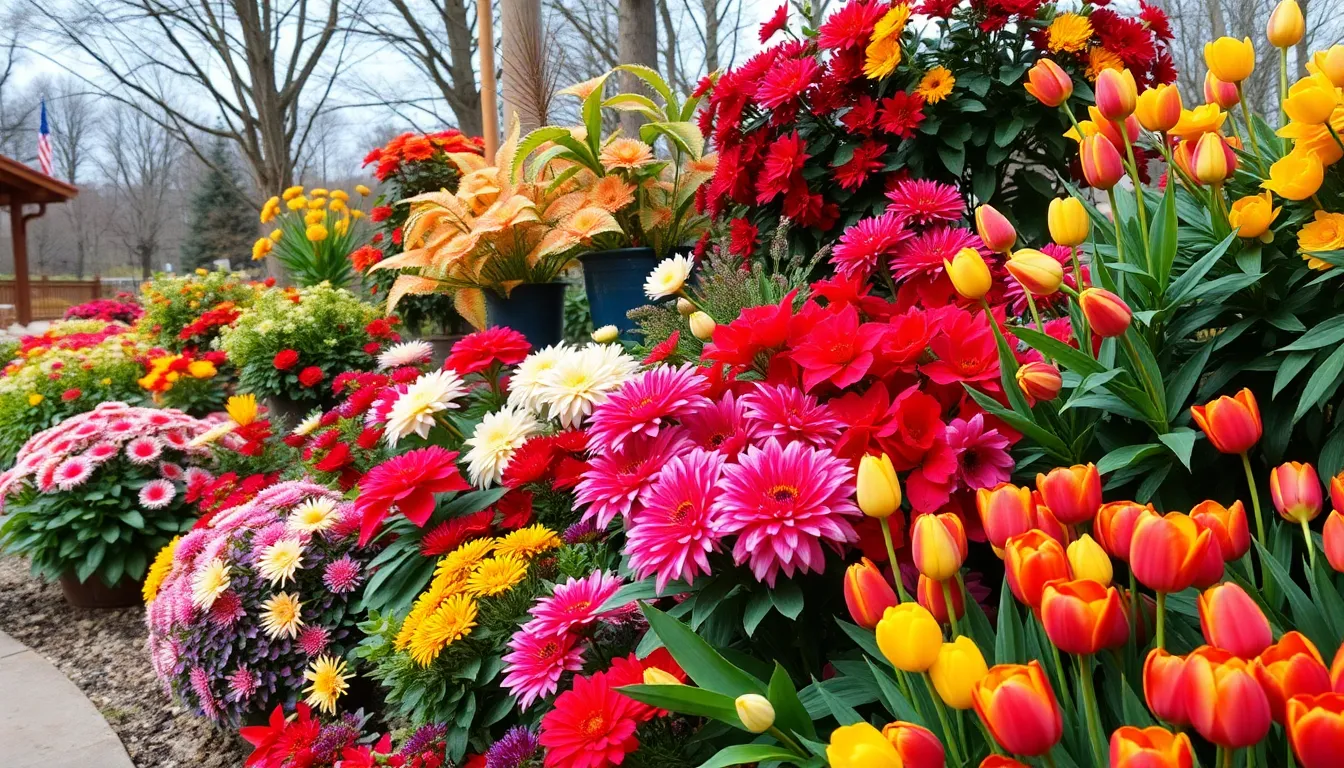
We can maintain continuous ornamental interest throughout all seasons by strategically selecting plants that peak during different times of the year. These three exceptional seasonal ornamental plants ensure our gardens and indoor spaces remain vibrant and captivating from spring through winter.
Chrysanthemum (Chrysanthemum Morifolium)
Chrysanthemums transform autumn landscapes with their composite flower structure consisting of hundreds of tiny disc florets in the center surrounded by colorful ray florets forming the familiar petals. These versatile ornamental plants showcase remarkable diversity through various bloom shapes including daisy-like single forms, globe-shaped incurve types, quill-shaped petals, pompom clusters, and miniature spray varieties called Santinis. We appreciate their extensive color palette featuring white, yellow, pink, red, and purple blooms that symbolize friendship, happiness, and well-being.
Planting these fall ornamental plants requires minimal effort since they thrive in rich, well-draining soil when planted in spring. Their low maintenance requirements make chrysanthemums ideal for both garden beds and container displays. Each bloom produces hundreds of seeds due to their composite flower structure, ensuring abundant propagation potential for future seasons.
Poinsettia (Euphorbia Pulcherrima)
Poinsettias bring festive winter color to our homes and gardens with their vibrant red and green foliage during the holiday season. These popular ornamental plants feature colorful bracts that surround small yellow flowers, though many people mistake the bracts for the actual blooms. We find their symbolic meaning of good cheer and success particularly fitting for Christmas decorations and winter celebrations.
Growing poinsettias successfully requires warm climates, indirect sunlight, and moderate watering schedules. Their seasonal availability coincides perfectly with winter holidays, making them essential ornamental plants for creating festive indoor and outdoor displays. These heat-loving plants complement our winter ornamental plant collections while providing the bright colors that other plants can’t offer during colder months.
Tulip (Tulipa Species)
Tulips herald spring’s arrival with their iconic cup-shaped flowers that bloom in brilliant arrays of red, yellow, pink, white, and multi-colored patterns. These perennial ornamental plants require a cold dormancy period during winter, which we achieve by planting bulbs in fall before the first frost. Their association with love and renewal makes tulips perfect for spring gardens and fresh floral arrangements.
Cultivating these spring ornamental plants involves fall bulb planting followed by patient waiting through winter’s cold months. We value their relatively short but spectacular blooming season that creates stunning displays in garden beds, borders, and containers. Their bright spring colors provide the perfect transition from winter’s dormancy to summer’s abundance, completing our year-round ornamental plant strategy.
Conclusion
We’ve explored an incredible variety of ornamental plants that can transform any space into a living masterpiece. From low-maintenance succulents to dramatic statement trees each category offers unique benefits for different gardening goals and skill levels.
The key to successful ornamental gardening lies in understanding your space conditions and matching them with the right plants. Whether you’re creating an indoor oasis with peace lilies and pothos or designing an outdoor retreat with Japanese maples and climbing vines the possibilities are endless.
Armed with this knowledge of plant names and characteristics you’re now equipped to make confident choices for your gardening projects. Remember that every expert gardener started as a beginner and with these reliable ornamental plants you’re well on your way to creating beautiful thriving spaces.
Frequently Asked Questions
What are the best ornamental plants for beginners?
For beginners, we recommend starting with low-maintenance plants like Pothos, Snake Plant, and Peace Lily for indoor spaces. These plants are forgiving and thrive with minimal care. For outdoor gardens, Marigolds and Petunias are excellent choices due to their vibrant blooms and easy growing requirements.
Which ornamental plants require the least maintenance?
Succulent ornamental plants like Aloe Vera, Jade Plant, and Echeveria species require the least maintenance. These drought-tolerant plants need minimal watering and can thrive in poor soil conditions, making them perfect for busy gardeners or those new to plant care.
What are good ornamental plants for indoor spaces?
Popular indoor ornamental plants include Pothos with its heart-shaped leaves, Snake Plant for its drought tolerance, and Peace Lily for its elegant white blooms. Tropical plants like Monstera Deliciosa and Fiddle Leaf Fig also make stunning indoor statement pieces with proper care.
Which ornamental plants provide both beauty and practical benefits?
Aromatic herb ornamental plants offer dual functionality, including Lavender with its fragrant purple flowers, Rosemary as an evergreen shrub with culinary uses, and various Mint species. These plants enhance garden aesthetics while providing ingredients for cooking and natural remedies.
What ornamental plants work best for vertical gardening?
Climbing and trailing plants are ideal for vertical spaces, including English Ivy for its hardy evergreen nature, Boston Ivy for seasonal color changes, and Morning Glory for vibrant trumpet-shaped flowers. These plants create privacy screens and maximize growing space in small areas.
Which ornamental plants bloom throughout different seasons?
For year-round interest, consider seasonal plants like Chrysanthemums for autumn color, Poinsettias for winter festive appeal, and Tulips for spring blooms. Combining plants with different blooming periods ensures continuous color and visual interest in your garden throughout the year.
What are the best statement plants for creating garden focal points?
Large ornamental plants that create dramatic focal points include Japanese Maple with its delicate lobed leaves, Magnolia trees with fragrant large flowers, and Weeping Willow with graceful cascading branches. These plants transform ordinary landscapes into extraordinary garden features.

